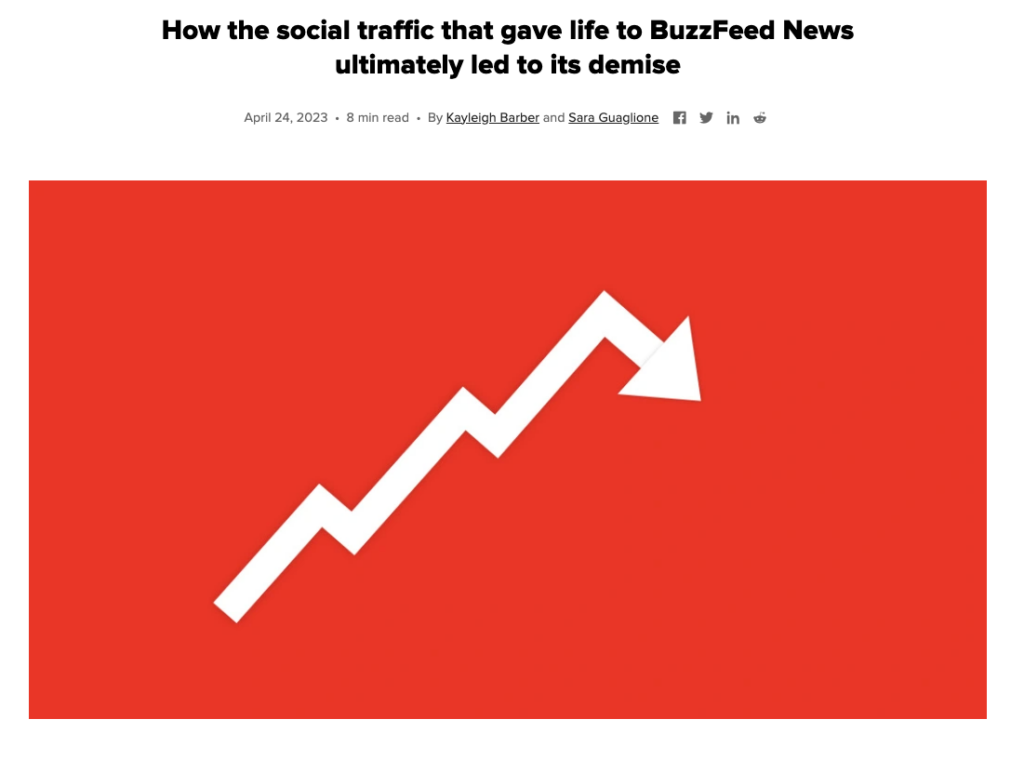The inbound traffic shift: Why building – not borrowing – an audience is the future
Seismic changes in inbound channels point to a future where owned land is even more importantInbound channels are a mess right now.
Let’s consider the evidence: Twitter is an ongoing saga. Facebook is in decline. Instagram and TikTok aren’t designed to drive traffic anywhere but their own platforms. Search is existentially threatened by AI, and changes to Google’s algorithm – scratch that, the product and service it provides overall – are certainly coming.
And the most recent case in point: the demise of Buzzfeed News.

Of course, we could see this coming right? These companies want to keep the traffic they have generated, and sell it to us. They don’t want to send anyone free traffic.
What does it all mean for inbound traffic strategy? I see three emerging scenarios, the first two the most attractive to platforms, and the third the real only option for maximizing platform reach for your own benefit:
- Pay. You’ll always be able to pay for traffic, and a paid-media-boost strategy is a good one, as long as it’s done very thoughtfully to stoke longer-term growth. But paid media isn’t a very attractive long-term strategy, especially if your conversions remain too low to justify it.
- Go Platform-Native. Build an Instagram account and become solely an influencer on a platform (or several platforms). This strategy is better than paying constantly, but you’ll lose the ability to build a stable, owned audience, so it’s risky. Plus, you won’t be able to execute a first-party data strategy, which will become more important as cookies are phased out.
- Be The Best. What’s left is the right to earn a direct audience through unique value – where you use the channels we’re talking about above to direct interest your way, but you don’t rely on any one of them – or any of them – to actually drive traffic to you, because you’re building your own audience of 1:1 connections through email, push notifications, text messages or some other direct means of communication. This only works if the content you’re providing is a real service that someone comes to rely on, and ideally they would promote it to others, creating an additional, authentic, organic, high conversion channel.
In that third scenario, you can actually deploy the entire audience development toolbox – paid, platform-native, whatever organic efforts still work after algorithms shift – as long as you are a good enough product to actively convert users to be in a 1:1 relationship with you, on a stable platform you can control.
This is the best way to achieve sustainable growth.
So it begs the question: How do you become the best? I think it’s a 5-part alignment exercise:
- Pick a niche audience that you can define, talk to, study, keep a pulse on. Know the problems they are trying to solve and solve them through content you publish first and foremost to a platform you own.
- Organize experts in that niche area to share their exclusive expertise (ideally they work at your company) in solving those problems. These experts become the source for the content you create and eventually, they can compete to become influencers in your space.
- Only talk about topics that actually matter to your audience. Do not waste anyone’s time. And don’t chase pageviews for pageview’s sake.
- Create formats that are unique, repeatable, easy to consume – and become known for them. Publish them to your owned platform and repurpose them to borrowed spaces – like social platforms – to extend your reach.
- Distribute in channels where your audience is, but always convert back to 1:1 owned channels. A bridge back to your owned space (with invites to build a deeper relationship, like through joining an email list) is essential to turning short-term success into sustainable success.
Don’t build exclusively on borrowed land if you want to develop an audience for your business. You can visit – you can even rent -but you need a place to call home in order to win in the long run.
Subscribe
Get our weekly newsletter for tips on how to drive better content marketing performance.
For a regular stream of ideas, research and links we find helpful. And of course, to say hi!
